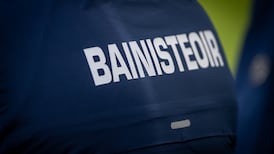That the GAA should be making approaches to Government with a view to getting the permitted limit of 200 at club matches relaxed is no surprise but it does throw up an irony.
Although the imperative to control Covid-19 is very real and paramount for both Government and sports organisations, public relations has also played a role.
It appeared likely that the decision to defer phase four of the exit from lockdown was at least partly about PR – necessarily emphasising to the public that the battle with coronavirus was ongoing and administering a reality check to those who appear to assume otherwise.
For the GAA PR hasn’t always been the easiest aspect of its operations down the years, sometimes obliging spokespersons to stand over the indefensible in relation to decisions of congress and other times requiring them to take unreasonable levels of flak.
The past week has presented problems from a different perspective: reasonable ideas failing to get traction in the public arena.
Originally, the figure of 200 was going to more than double to 500 with the commencement of phase four, scheduled for last Monday, but last week’s decision to ‘pause’ left the upper limit as it was.
Obviously it’s an issue for all sports but Gaelic games have been first out of the traps with a nationwide programme of competitive matches and units around the country are feeling the pinch in administrative terms with tickets – generally clubs are allocated about 50 per match – proving a nightmare.
There’s not a pile of substance to the decision to allow no more than 200 attend matches.
A uniform ceiling on outdoor events makes no sense on two levels: one, the vast disparity in capacity from club grounds to somewhere like Wexford Park, never mind Semple Stadium et cetera; two, as protested by Wexford, beaches and public parks are overrun on sunny days with generally (some people were turned away from Duncannon by Gardaí at the weekend) little limit on numbers or any attempt made to ensure adequate spacing.
In general GAA president John Horan has led well during the pandemic. His public statements have been measured and appropriately cautious. It's all very well to criticise him for saying in April and May that a return of the games would be very difficult as long as social distancing was a public health requirement when that concern is now largely qualified.
But his sentiments at that time were in keeping with the advice of the health authorities, whose own views have also evolved as circumstances have changed to the point where some risk of infection is regarded as a price that has to be paid for any readjustment to normality.
In the case of the GAA, it was the medical experts on its Covid Advisory Group who pushed for acceptance of that very trade-off, because a failure to get the games up and running would pose its own risks in the long run.
The lengthy, cautious roll-out of protocols, checks and balances that has accompanied all of the steps forward has been to the credit of Horan, DG Tom Ryan and the relentlessly busy head of games administration Feargal McGill, who also sits on the Government's Return to Sport Expert Group.
If there was a misstep, it came with the failure to threaten punishment on counties, who were interfering with club access to players by breaking the guidelines on collective training but that was addressed.
Last Friday, however, wasn’t a great idea either. The president went on Morning Ireland and ‘openly called on’ Government to review the attendance restrictions governing Gaelic games. This was just two days after the announcement that phase four of the national exit from lockdown would be deferred.
This was at a time when counties, notably Wexford, were making perfectly valid submissions that significantly bigger crowds, four times the limit, could be accommodated within the rules of social distancing, which would have allowed 2,000 into Wexford Park with adequate space and separate gates for each of four pods.
At most that would be 10 per cent of the capacity. Apply that to bigger grounds and it eases the pressure on tickets without compromising public health requirements.
There were also practical problems with the direct approach. How would the Government react to their sombre announcement on the Wednesday being so immediately disputed?
It was a bit optimistic to think that a public intervention so soon afterwards would cause much more than irritation, especially for a Government beset by troubles early in its existence and with a major EU summit on the horizon. Would the cabinet want to be accused of folding to the demands of Croke Park?
In the case of the GAA there is always the danger of blow-back and that duly emerged over the weekend – no matter that the arguments against the president’s call didn’t engage with the argument and some accused the association of looking for exceptions to be made for its games.
In fact the association was simply looking to be treated the same as everyone else and be allowed to operate its activities while observing the rules on social distancing – and the same would go for any outdoor activity.
Given that the 200 limit was always going to apply last weekend it might have been a better idea to say nothing until after the first two weeks.
Nothing after all makes the case more eloquently than a series of incident-free programmes around the country with the television pictures framing the absurdity of the limits.
It is more than likely that there will be an easing of the restrictions, simply because it’s the sensible thing to do but it’s also advisable to be patient. Governments tend not to like being badgered in public and when your arguments are strong, there’s no real need.
smoran@iristimes.com











